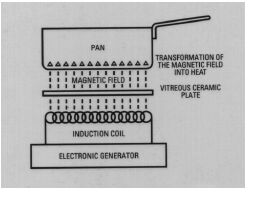NEW SEARCH NEW SEARCH, STATE - ACT
First Prev
DISCLAIMER:
Whilst all care is taken to provide accurate information with respect to the item described, the Independent Living Centre (ILC) is not involved in product design or manufacture, and therefore not in a position to guarantee the accuracy of the information provided. Selection of equipment, which is both suitable and appropriate for individual needs remains the responsibility of the person(s) considering requisition, and no responsibility is taken by the ILC for any loss or injury caused through use of the equipment or alleged to have arisen through reliance upon information provided. As information is subject to change any enquiries should be directed to the manufacturer.
Item Details
A Buyers Guide - Induction Cooktops
ILC Reference NO 81:20:601
Item sourced from ILC ACT database

Short Description
Induction cooktops produce heat only within the pan itself. An induction coil just beneath the ceramic surface produces a magnetic field. This induces high frequency magnetic waves in the metal base of the pan, thus heating it. Energy is transferred directly to the food, eliminating the energy waste which generally occurs with conventional hotplates and boiling tops.
More Details
. The ceramic cooktop under the pan does not heat up, although some heat is conducted from the pan back to the cooktop.
. Spilt cooking fluids do not burn onto the cool surface so less time and
energy is spent cleaning.
. The cooktop heats only the pan and not the kitchen so air temperatures remain lower.
. The absence of flames means safety from fire.
. Induction cooktops produce an instant rise in temperature within the pan which means faster cooking times for most food items.
. They are capable of detecting if a saucepan has boiled dry. Some models automatically turn off, while others turn down.
. Electronic controls allow the cooking to be finely controlled from gentle cooking to rapid boiling.
. Energy is consumed only when the pan is on the cooktop.
. Safer than conventional cooking.
. More expensive than other cooktops
. Hotplates in a parallel arrangement (square with 4 plates)
Additional Comment
. The cooking pan must have a magnetic base eg. steel, cast iron or magnetic stainless steel. The heating mechanism is activated or stopped by placing or removing the pan on the ceramic hob.
. Element size - pots and pans need to be within, or close to, the diameter of the hotplates. Pans that overhang won't heat properly around the edges, and pans that are too small won't be recognised.
. Controls should be logical, and clearly show the power settings. there should be some sort of visual or physical separation from the hotplates. They should be located at the front of the cooktop within easy reach.
. Location of hotplates / elements - current models have a parallel arrangement of four hotplates (2 at the front and 2 at the back). Where possible, avoid having to reach over one hot cooking pan to reach another.
. Power on / residual heat light - this should be bright, visible and located near the controls. Each hotplate should ideally have its own indicator.
. Auto heat-up - this feature allows the hotplate to heat to a higher setting, then automatically turn down to a preset setting after a certain amount of time.
. Timer - "turn off" timers for at least some hotplates as well as a separate timer can be useful.
. Safety switching - look for models that automatically turn off or down in the event of overheating, and models that turn off if a hotplate has been left on for an extended period of time.
. Booster. Some models have a setting that produces very high heat, ideal for boiling water fast but too hot for cooking most foods. This may not be considered a necessary feature.
Supplier Information - click to supplier for contacts details
Additional /images
No additional /images apply to this item
First
Prev ![]()
![]() Next
Last
Next
Last
